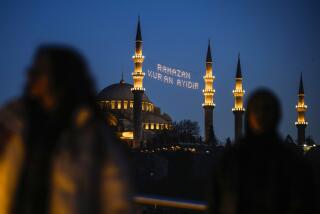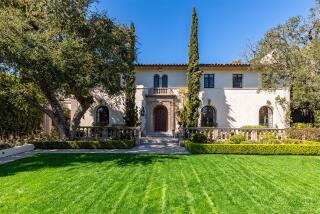Turkish Blend
ust as Istanbul straddles the two continents of Asia and Europe, Arzu Osborneâs Turkish home in Orange combines old and new, East and West, European elements and Islamic symbols.
Her collection of furniture, rugs, crystal and copper from her native Istanbul looks comfortable in her contemporary, two-story home.
âIâve decorated my house here very much like my motherâs in Istanbul,â says Osborne, who moved to the United States in her 20s and met her future husband, Jim. âMy mother has the same kind of Italian marquetry table in her living room that I have. She also has two end tables with Austrian lamps on them.â
There are objects throughout the house that are reminiscent of the Ottoman Empire--copperware, ceramics and carpets.
In the living room, there are sheer curtains with a Middle Eastern design, a painting of a Turkish village girl over the fireplace and, on the mantel, a 100-year-old hand-crocheted linen runner her grandmother made.
In one corner of the room sits the piano that the coupleâs 15-year-old son, Eren, plays. It also has an antique crocheted runner on top, and hanging on the wall behind the piano is a silver mirror with its glass side facing the wall.
âIn the old times, they werenât supposed to have mirrors around the house, but people needed mirrors,â Osborne says. âSo they would turn them over so you couldnât see the glass side, but only the silver embossed decoration on the back.â
High above a picture window near the entrance is a large, pear-shaped blue glass.
âItâs an âevil eye.â We grew up with them,â Osborne says, adding that when the Crusaders arrived in Istanbul (then Constantinople) in 1204, they were the first people with blue eyes the Turks had ever seen. Because the Crusaders were such fierce fighters, the Turks decided to fight fire with fire and wore âblue eyesâ pinned to their clothes to repel the invaders.
Having them in their homes remains a Turkish tradition, she says.
Throughout the house are crocheted linens from her mother and grandmother. The most prized is the hand-crocheted bedspread in the master bedroom.
âThe beauty of it is that all the angels are pointing toward the center,â she says. âThat made it difficult since she really had to keep track of what she was doing.â
Also among the treasures in the Osbornesâ home are the Turkish carpets in the living room, bedroom and kitchen.
Two Hereke rugs, one of wool and another of silk, are in the living room.
The first Herekes were created in the 19th century by order of the sultan for his palaces. They are considered among the finest carpets in the world, because of the millions of hand-tied knots per piece.
âTurkish women are still making these, but once they get beyond 20 years old, they canât do it anymore because they lose their eyesight for such detailed work,â Osborne says.
The rugs go into dowries and are often sold when the girls marry.
The chandelier in the Osbornesâ dining room is made of Czechoslovakian crystal and hand-painted Bohemian porcelain. Itâs similar to one found in the Dolmabahce Palace along the Bosporus. The palace was built in 1843 and was the home of the sultans until 1922. Kemal Ataturk, the founder of the Turkish republic, lived there until he died in 1938.
âJim picked out the chandelier and then we realized it was the same as one in the Dolmabahce Palace,â Osborne says. âIt was a coincidence. It wasnât as if we were running after it. This style was very popular about 100 years ago in Turkey.â
European influence is also evident in the dining room, with the Biedermeier-style furniture and the Czechoslovakian glasses. The silver on the sideboard is Turkish, as are some silver pieces in the kitchen.
Though the Osborne kitchen canât compete with those at the Topkapi Palace, which by the 17th century had a staff of 1,300 to feed as many as 10,000 people a day, there are elements from the Ottoman Empire there. The antique copper utensils on the wall, the copper pots doubling as plant holders, the silver serving pieces and the Turkish teapot. There are often baklava and mezes (hors dâoeuvres) on the counter.
âWe go back to Turkey every year because I like to see my family and I like to go shopping there,â she says.


